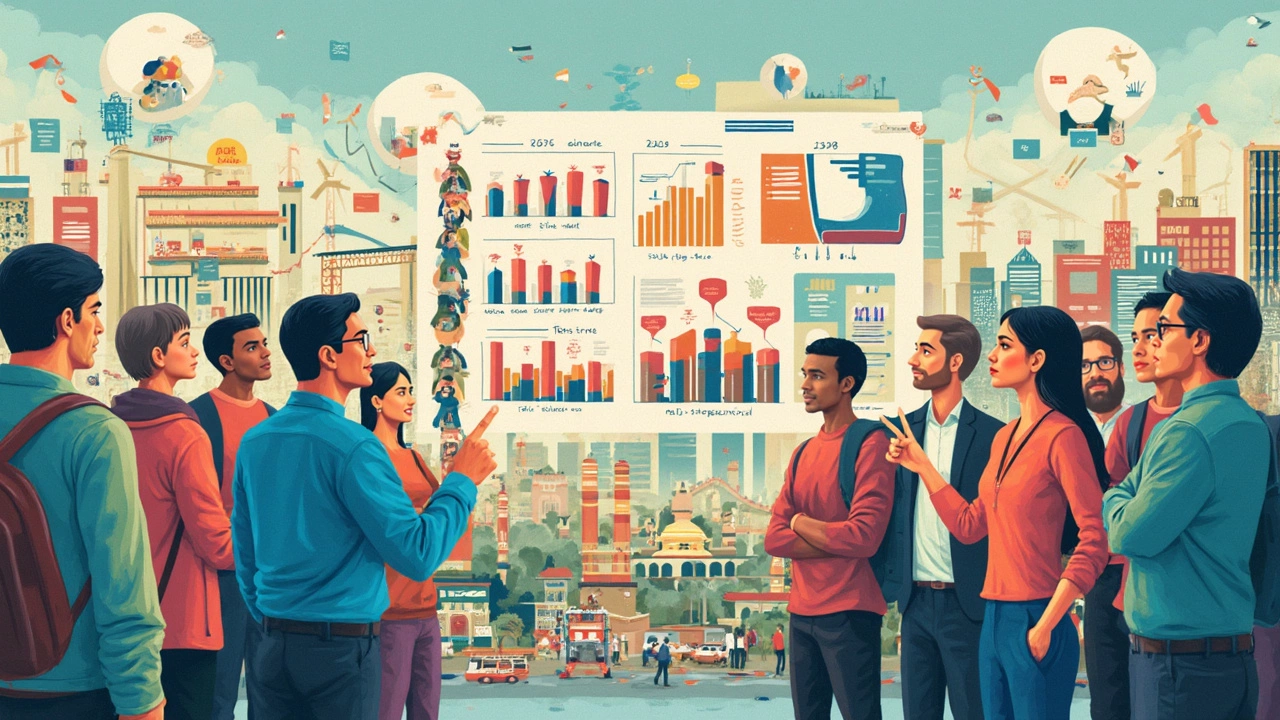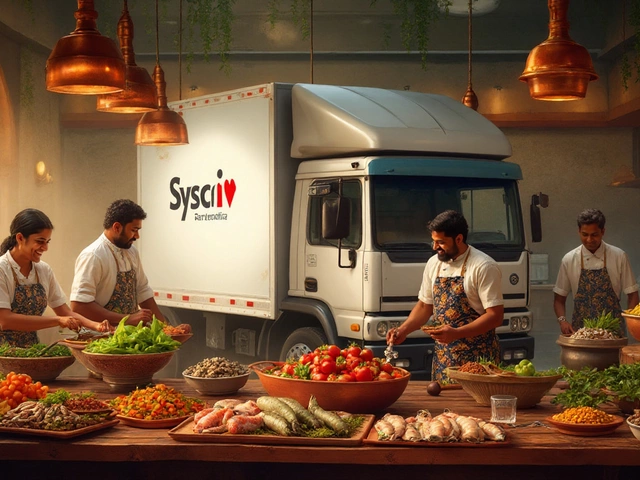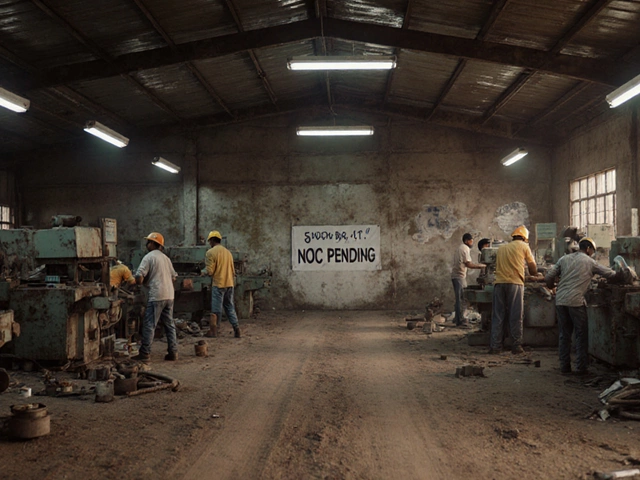You’ve probably seen headlines claiming American factories are vanishing, and it’s easy to forget how much the country once relied on making stuff. Cars, appliances, even sneakers—these things used to roll out of US plants in huge numbers. Now, many of those products are stamped “Made in China” or “Made in Vietnam.” For lots of people, this shift feels like the whole foundation has changed beneath their feet.
But does America really need a massive manufacturing base to stay successful? Or can it keep growing by focusing on services and tech? If you work in healthcare, code for a living, or even run a coffee shop, this question affects you more than you might think. It links directly to the government programs you hear about—like subsidies for chip makers, tax breaks for electric cars, or big investments in research labs.
It’s not just about distant plants and faceless corporations. We’re talking about real paychecks, real towns, and whether the country can hold its own when countries like China ramp up their own factories. So, how did we get here? And what actually works when it comes to government trying to boost manufacturing? If you’ve ever wondered whether the US can stay on top without making things itself, or if you’re curious where your next paycheck might really come from, you’re in the right place.
- Why Manufacturing Used to Matter So Much
- How America’s Economy Has Shifted
- What Government Schemes Are Doing Right Now
- Jobs, Wages, and the Middle Class
- Innovation: Can Services Replace Factories?
- What’s Next for American Manufacturing?
Why Manufacturing Used to Matter So Much
For most of the 20th century, the US was the world’s factory floor. Manufacturing pumped life into cities—think Detroit’s auto plants or Pittsburgh’s steel mills. This sector didn’t just make goods; it supported millions of stable, middle-class jobs, even for folks without college degrees. Back in 1950, almost a third of US workers had manufacturing gigs. Those jobs paid well enough for people to buy houses, send their kids to college, and enjoy weekends off. That’s no small thing.
Manufacturing also had a domino effect. When factories thrived, they needed suppliers, truckers, repairmen, machine shops, and even lunch spots nearby. Economists call this the multiplier effect—each factory job can create two or three more jobs in the community. For policymakers, supporting this part of the economy looked like an easy win.
And there’s another side: national security. During World War II, America’s massive plants shifted overnight from making cars or fridges to tanks and planes, showing why it mattered to make things at home. Plus, being the leader in advanced manufacturing helped the US stay ahead in technology, from semiconductors to jet engines. Here’s a look at some data showing how big a deal manufacturing was for the country:
| Year | Manufacturing Jobs (Millions) | % of US Workforce | Manufacturing as % of GDP |
|---|---|---|---|
| 1950 | 16.8 | 30% | 28% |
| 1980 | 19.3 | 22% | 22% |
| 2022 | 12.6 | 8% | 11% |
Back in the day, the US economy and even society itself leaned heavily on a strong manufacturing base. For anyone who grew up with parents or grandparents on the line, this wasn’t just a job—it was a ticket to a better life. That’s what made manufacturing such a big deal, and why its decline still hits home for so many Americans.
How America’s Economy Has Shifted
If you take a quick look at the US economy now compared to what it was a few decades ago, the change is hard to miss. Manufacturing was once front and center — picture big companies cranking out cars in Detroit or TVs in Ohio. In the 1950s, over 30% of American workers had jobs in factories. Fast forward to 2025, and it’s less than 9%.
This isn’t just trivia. It’s a total shift in how people earn a living. You see way more jobs in healthcare, technology, finance, and even delivery services. Meanwhile, plenty of towns that depended on factories have struggled to keep up. It’s not just about where we work — it’s about what the country produces and sells to the world.
Here’s what really happened:
- More stuff started getting made overseas, where labor costs are way cheaper. That made it tough for US factories to compete.
- New tech, automation, and robots meant factories needed fewer people on the floor to get the same amount done.
- The US economy leaned harder into things like software, financial services, and healthcare. These sectors often pay more, but usually need a college degree or higher skills.
Still, US economy is huge, and services now make up almost 80% of it. Even the biggest companies, like Apple and Google, aren’t really in the business of making things in America, but designing and selling ideas or digital tools.
| Year | % of Jobs in Manufacturing | % of Jobs in Services |
|---|---|---|
| 1955 | 32% | 50% |
| 1995 | 15% | 70% |
| 2025 | 8.4% | 78.6% |
This change didn’t just happen by accident. Trade deals, new tech, and shifting consumer habits all played a role. For some families, the move away from factories has meant better pay and safer work. But for lots more, especially in smaller towns, it’s been tough. You hear stories of closed plants and empty main streets all over the north and Midwest.
It’s not all bad news — just different. The challenge now is whether America can keep thriving when most new ideas and paychecks aren’t coming from assembly lines, but from digital screens or health clinics. It sets the stage for why people care about those government schemes aimed at reviving, or at least supporting, what’s left of manufacturing.
What Government Schemes Are Doing Right Now
The US government hasn’t been sitting on its hands. Lately, billions have been pushed into jumpstarting the manufacturing engine, especially in the tech space. You might’ve heard about the CHIPS Act—it’s not about potato chips, but making computer chips (semiconductors) right here in the US. The government pledged around $52 billion in this plan over the next few years to give companies cash and tax breaks if they build and expand chip factories stateside.
That’s not the only game in town. The Inflation Reduction Act of 2022 is set to pump over $370 billion into clean energy projects. Electric cars, solar panels, batteries—if a company wants to make those in America, there’s a buffet of tax credits, grants, and low-interest loans waiting for them. The end goal? More jobs, less pollution, and a shot at getting ahead in the global tech race.
If you look under the hood, these government schemes are hoping to patch up a big worry: the US doesn’t want to depend on other countries, especially for tech that powers everything from cars to the country’s defense systems.
- US economy gets a boost in areas like semiconductors and green tech.
- States compete for factories with tax breaks and training programs—Ohio snagged Intel’s $20 billion new chip plant in 2022, while Georgia and Texas landed big electric vehicle battery factories.
- Some federal programs try to retrain workers who lost jobs during factory closures, helping them shift to new industries.
| Program | Investment Amount | Main Focus |
|---|---|---|
| CHIPS Act | $52 billion | Semiconductor Manufacturing |
| Inflation Reduction Act | $370+ billion | Clean Energy Projects |
| Advanced Manufacturing Tax Credit | $10 billion/year | Factory Construction & Equipment |
For all the money on the table, what actually works? Experts say direct investment, like cash grants and tax credits, tend to make the biggest dent—especially when the jobs created offer good wages and long-term growth. But it’s a balancing act: money floods in, but sometimes companies pocket the benefits and jobs go overseas anyway. That’s the tough part Washington keeps wrestling with. For now, the big bets are on microchips, batteries, and clean energy as the new anchors for America’s manufacturing push.

Jobs, Wages, and the Middle Class
If you’ve got family or friends who once worked in factories, you know how the disappearing manufacturing jobs hit home. Since the late 1970s, the share of Americans working in manufacturing dropped from about 20% to less than 9% in 2024. That means millions of jobs moved overseas or got wiped out by automation. Whole towns felt it—the kind you see in the Midwest and South where plants once anchored the community.
The biggest punch from losing these jobs? The middle class got squeezed. Manufacturing jobs used to mean decent pay and good benefits even if you didn’t have a college degree. In 2019, according to the Bureau of Labor Statistics, the average manufacturing worker earned about $28 per hour, compared to only $25 in retail and $21 in hospitality. Plus, these jobs often came with health insurance and retirement plans. That’s why older folks look back and talk about the stability factory work used to offer.
Here’s a quick comparison of job numbers and hourly pay in recent years:
| Sector | Jobs in 2024 (millions) | Average Hourly Wage (2024) |
|---|---|---|
| Manufacturing | 12.6 | $29 |
| Healthcare | 21.1 | $27 |
| Retail | 15.3 | $25 |
| Hospitality | 16.8 | $22 |
Some government programs have tried to patch the hole. Job retraining, tax breaks, and trade adjustment assistance are just a few ways Washington has tried to steady things. But the problem is, many of the new jobs popping up in services and retail don’t pay as much or offer solid benefits. It’s a tough pill to swallow: more jobs, but fewer that actually make it easy to support a family or buy a home.
If you’re wondering if the US economy can work without its old manufacturing base, the answer depends on whether new jobs can really replace what’s been lost. For a lot of folks, it feels like the middle class is hanging by a thread unless there’s a solution that brings back decent wages, not just any job that’s available. If you’ve seen younger people in your family juggling multiple gigs just to pay rent, you get what this shift actually means on the ground.
Innovation: Can Services Replace Factories?
People like to talk about the big switch from making things to offering services—think Google, Amazon, and all the tech and finance jobs that didn’t exist a few decades ago. The question comes up a lot: Can the services sector really fill the gap left by old-school manufacturing? Short answer: it helps, but it’s not a simple swap.
First, here’s some straight-up truth: the US services sector has exploded. Today, it makes up around 77% of the country’s GDP, with jobs in healthcare, tech, retail, and finance. Meanwhile, manufacturing has shrunk to less than 11% of GDP, based on data from the Bureau of Economic Analysis. That’s a huge flip from the 1960s, when manufacturing ruled the roost. Here’s how that looks in numbers:
| Sector | Share of US GDP (2024) |
|---|---|
| Services | 77% |
| Manufacturing | 11% |
Now, don’t get me wrong—services create tons of value. The tech sector especially spins out some wild innovation and giant companies. Take cloud computing or the rise of fintech apps. Those weren’t even things 20 years ago. Also, services tend to grow faster and can scale quickly. Think about how Netflix or Uber pulled in millions of customers worldwide without building a single factory.
But here’s the catch. Most high-wage, high-skill jobs in tech or finance need specific education, and they’re not jobs that everyone who used to work in factories can jump right into. The truth is, the service sector runs a broad spectrum—yes, there are well-paid engineers, but also tons of lower-paid positions like home health aides or restaurant staff.
- The *strongest* US economy (there, I said it: US economy) often relies on both solid factories and smart services.
- Tech and services often depend on things made by manufacturers—think about all the servers, laptops, and gadgets out there.
- Research from MIT found major tech innovation still ties back to manufacturing know-how—meaning places that build stuff usually stir up more patents and inventions.
So, jobs in services and tech can make up a lot of ground, but it hasn’t totally replaced what manufacturing did for middle-class pay and stability. That’s why you’re seeing government drops billions into homegrown chip factories or clean energy plants right now.
If you’re watching this at home, the big takeaway: services are key to the modern economy, but manufacturing still plays a behind-the-scenes role in driving progress, high wages, and real security.
What’s Next for American Manufacturing?
The story isn’t over for American factories. In fact, manufacturing is at a turning point because everything from chip shortages to global politics has forced leaders to rethink what gets made at home. Take the CHIPS and Science Act, passed in 2022—this law pumped $52 billion into American semiconductor manufacturing. For those who don’t follow tech news, that means the U.S. government is betting big money to bring computer chip production back stateside and reduce reliance on Asia.
There’s also the push for electric vehicles (EVs). With brands like Tesla, Ford, and GM racing ahead, factories in places like Michigan and Texas are changing to make batteries and EVs. Local governments are handing out incentives like tax breaks and cheap land, hoping to become the next hub for the industry. This isn’t just about building cars—these investments create jobs installing charging stations, running supply chains, and training workers.
Even with all this action, the US economy doesn’t look anything like it did fifty years ago. Robots and automation are doing a ton of work that humans used to do. According to the Bureau of Labor Statistics, manufacturing employment is just over 12 million jobs today, but output (meaning factories are producing more) is near all-time highs. So, it’s not about bringing back millions of old factory jobs—it’s about training workers for new kinds of jobs that keep up with the tech.
- Modern factories need people who can run and fix robots, not just work on assembly lines.
- Apprenticeship programs, like the one Toyota uses in Kentucky, help students go straight from high school to skilled manufacturing jobs—no fancy degree needed.
- Smaller cities are also jumping in. Towns like Greenville, South Carolina, and Columbus, Indiana, have seen new life thanks to advanced manufacturing in cars and aerospace.
If you’re thinking about where the opportunity is, it’s probably not in making simple stuff like cheap toys. It’s in high-tech products—chips, batteries, medical equipment—and figuring out how to keep the edge. That means government policies, local leaders, and even schools all have to work together to train people for what factories really look like now. This shift won’t make every town a tech paradise overnight, but real growth will come from factories that are smarter and leaner, not just bigger.





